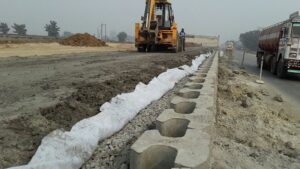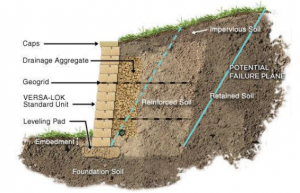Geosynthetics in Road Construction

Geosynthetics are the key components of a system or structure that is used to achieve different engineering aspects or purpose.
Normally, Geosynthetics products are produced from a polymeric material. Geo signifies the Earth which represents the soil whereas the synthetics represent the polymeric material or synthetic materials.
From the name we can recognize, the synthetic material used to increase soil stability is called geosynthetics.
Various categories of geosynthetic materials are used for various purposes such as reinforcement, filtration, separation, drainage, water barrier, etc.
Geosynthetic materials are utilized in Soil related projects of construction. Like it was mostly utilized in roads, railways, dams, hydraulics, retaining walls, canals, marine structures, foundations, embankments, etc. construction projects concerning soil in the civil engineering profession.
Geosynthetic material is the most suitable material for inside-ground usage because of its synthetics nature and high endurance of that material.
The main goal of geosynthetic materials is to increase the stability or strength of soil and lessen construction costs.
Functions of Geosynthetics
The Prime Functions of Geosynthetics are listed below:
- Soil Reinforcement
- Separation
- Filtration
- Drainage
- Moisture barrier
- Soil Reinforcement
The soil reinforcement function assures an improved response of the soil to loading. It expands normal loading and lessens disturbing shear forces.
As an outcome, steep slopes can be constructed or an embankment of increased height be built on soft soil, which differently would not have been possible.
Separation

Geosynthetics are beneficial to separating dissimilar soils. A separator assists prevent intermixing of poor in situ soil with good-quality granular materials when the structure is subjected to surface loading.
It functions as a barrier to the migration of particles between two dissimilar soils, a requirement in many applications like pavements, graded filters, clay covers, liners in landfills, etc.
Filtration
Geosynthetics like geotextiles allow the movement of a liquid across the plane of geotextile while retaining the soil on the upstream side.
To obtain this, the material should fulfill conditions of both adequate permeability, requiring an open fabric design, and soil retention requiring a less opening size.
The long-term soil-to-geotextile flow compatibility is as well important in that the filter must not clog excessively during its lifetime.
Drainage

The drainage function of geotextiles empowers flow in the plane of geotextile. Besides geotextiles that transmit the fluids, their specific products like geonets and drainage composite fulfill drainage requirements
Barrier
The barrier function utilizing geomembranes and geotextiles coated with bitumen is advantageous in many applications for minimizing fluid and vapor flow. It is beneficial in many applications such as canal linings, liquid impoundments, dams, municipal waste landfills, etc.
4 ADVANTAGES OF GEOSYNTHETICS IN ROAD CONSTRUCTION
Geosynthetics have a variety of purposes from erosion control to embankment reinforcement to improved subsurface drainage. One of the most common purposes, howbeit, is in road construction, particularly temporary roads like construction roads, access roads, and forest routes. These are the advantages of using geosynthetics for these applications.
Bearing capacity
For architecting both roads and parking lots, it’s vital to subgrade is stable with sufficient bearing capacity. By utilizing geogrids between the subsoil and base course, bearing capacity is expanded. The interlocking of the cover soil with the geosynthetics offers horizontal force transfer, which serves to enhance bearing capacity and, in many situations, allows for base course thickness to be lessened. This method as well makes expensive soil exchange unnecessary.
Rutting
One of the main concerns when building unpaved roads on soft subsoil is rutting and inter-blending of cover material into the subsoil. By enhancing load distribution, geosynthetics serve to lessen both rutting and soil interblending. A specific project’s requirements will state the specifications of the geogrid needed.
Force-extension
Low extension features of a geosynthetic are needed for a successful reinforcement application. In many undertakings, force absorption at elongation needs a product with between 2 percent and 5 percent quantity. For more demanding purposes, products with up to 8 percent extension at break are available.
Installation robustness
Finally, it’s essential to consider a geosynthetics resistance to installation loads. High dynamic stresses can take their toll on reinforcement at the time of installing and condensed cover soils and base course elements. To endure this stress, a geosynthetic should have thick, monolithic reinforcement bars.
Using geosynthetics offers a more cost-effective and efficient way than many alternatives in a variety of applications.
Have a query, give us a phone call and situate us to the test.
Ocean Global is the best Geosynthetics Company in India as we have geosynthetic engineering solutions that are all-around, solid, and adaptable to meet your project requirements. We have geosynthetic engineering solutions that are versatile, robust, and adaptable to suit your project requirements. Contact Us Now



